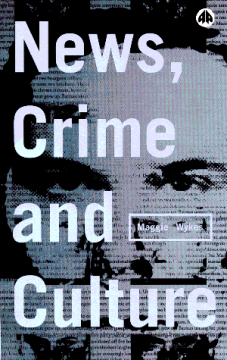
Additional Information
Book Details
Abstract
Crime is always newsworthy. But is crime reporting as value-free and objective as we would like to think? Is crime reporting concerned exclusively with issues of good and evil, justice and the law? Or is it part of a broader and much more specific ideology, underpinned by an essentially conservative agenda?
The link between news reports of crime or disorder and public perception becomes increasingly clear, as public reaction to the murder of Sarah Payne and the fuel crisis has shown. News, Crime and Culture explores these links, assessing the relation between culture, criminality and social control, and in particular the ways in which news reports reinforce particular responses to race, poverty, class and gender.
Maggie Wykes uncovers these links through a variety of high-profile events featured in the news, spanning the last twenty years of the twentieth century. She examines such issues as child abuse, football hooliganism, homelessness, youth culture, inner-city crime, prostitution, pornography, homosexuality, and domestic violence. Using case studies and a range of methodological analyses, Wykes turns the business of crime reporting inside out, revealing the hidden agendas that not only report but shape our view of the world in often insidious ways.
'A significant empirical and theoretical contribution to our understanding of the dynamics of mediated language in disguising and perpetuating power across a range of significant issues of conflict during the Thatcher years'
Andrew Hoskins, University of Wales, Swansea.
Table of Contents
| Section Title | Page | Action | Price |
|---|---|---|---|
| Contents | iii | ||
| Introduction | 1 | ||
| Content | 1 | ||
| Organisation | 2 | ||
| Figures and Tables | 1 | ||
| Table 1.1: News Criteria from Galtung and Ruge ( 1965) | 23 | ||
| Table 1.2: British Values from Chibnall ( 1977) | 24 | ||
| Figure 1 | 40 | ||
| Figure 2 | 41 | ||
| Table 6.1 Gender Value Grids: Guide to Dominant Model | 158 | ||
| 1. Criminological Crises | 8 | ||
| Criminology | 8 | ||
| Critical Shifts | 9 | ||
| 2. Disorderly Publics: Race in the Inner Cities | 30 | ||
| Roots of Disorder | 30 | ||
| Race in Britain | 32 | ||
| Race and the Media | 33 | ||
| Race and the Media during Thatcherism | 35 | ||
| Media and Method: Broadwater Farm | 42 | ||
| 3. Public Order: Criminal Class | 60 | ||
| Causes of Disorder | 61 | ||
| Class, Community and Conflict | 63 | ||
| The Miners' Strike 1984-85 | 68 | ||
| Terror on the Terraces | 76 | ||
| Comment | 82 | ||
| 4. High Jinks: Youth, Crime and Community | 86 | ||
| Youth Culture, Crime and Class | 88 | ||
| New Age Travellers | 91 | ||
| Raves | 93 | ||
| Taking the Streets | 96 | ||
| 'The devil himself couldn't have made a better job of raising two fiends (Sun, 25.11.93) | 99 | ||
| Drugs | 100 | ||
| Protest | 103 | ||
| Comment | 106 | ||
| 5. Beggars Not Choosers | 112 | ||
| An Englishman's Home | 114 | ||
| Homelessness and the Media | 116 | ||
| Housing Advice | 117 | ||
| Media, Myths and the 'Real' Issues of Homelessness | 118 | ||
| Single and Homeless in Leeds | 121 | ||
| Lone Parents in Leeds | 123 | ||
| Press Ideology | 128 | ||
| Comment | 135 | ||
| 6. Journalism, Justice, Gender and Violence | 138 | ||
| Handbagged | 139 | ||
| The Power to Represent | 141 | ||
| Sex'n'Violence in the News | 143 | ||
| Sex and Violence and Feminism | 147 | ||
| News about Intimate Killing: Ideology About Gender | 148 | ||
| Mercy for the Killer who Bit Back | 151 | ||
| Evaluating Blame | 153 | ||
| Comment | 160 | ||
| 7. Straightening Out Sex | 164 | ||
| Body Talk | 165 | ||
| Prostitution: Sex for Sale | 167 | ||
| Sectioning Homosexuality | 171 | ||
| Keeping it in the Family | 175 | ||
| Pornography and the Mass Media | 178 | ||
| Effects and Ethics | 180 | ||
| Comment | 184 | ||
| 8. News Cultures | 187 | ||
| Notes | 206 | ||
| Chapter 1 | 206 | ||
| Chapter 2 | 208 | ||
| Chapter 3 | 209 | ||
| Chapter 4 | 209 | ||
| Chapter 5 | 210 | ||
| Chapter 6 | 210 | ||
| Chapter 7 | 211 | ||
| Chapter 8 | 212 | ||
| Appendix | 214 | ||
| Table 1: Selected Cases and Accounts | 214 | ||
| Table 2: Exemplars of Value Assessment Process | 214 | ||
| Table 3: Gender Evaluation Process | 215 | ||
| Figure 3: Perpetrator/Victim/Law: Evaluations as % of All Agency | 215 | ||
| Figure 4:Explanation Type and Value: Gendered Discourses | 216 | ||
| Bibliography | 217 | ||
| Index | 230 | ||
| Adam Smith Institute, 185 | 185 | ||
| Adler, F., Sisters in Crime, 14 | 14 | ||
| advertising | 32 |
